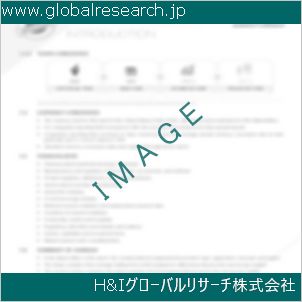Table of Contents
1 Industry Overview of Propazine
1.1 Definition and Specifications of Propazine
1.1.1 Definition of Propazine
1.1.2 Specifications of Propazine
1.2 Classification of Propazine
1.3 Applications of Propazine
1.3.1 Nuclear Application
1.3.2 Non-Nuclear Application
1.4 Industry Chain Structure of Propazine
1.5 Industry Overview and Major Regions Status of Propazine
1.5.1 Industry Overview of Propazine
1.5.2 Global Major Regions Status of Propazine
1.6 Industry Policy Analysis of Propazine
1.7 Industry News Analysis of Propazine
2 Manufacturing Cost Structure Analysis of Propazine
2.1 Raw Material Suppliers and Price Analysis of Propazine
2.2 Equipment Suppliers and Price Analysis of Propazine
2.3 Labor Cost Analysis of Propazine
2.4 Other Costs Analysis of Propazine
2.5 Manufacturing Cost Structure Analysis of Propazine
2.6 Manufacturing Process Analysis of Propazine
3 Technical Data and Manufacturing Plants Analysis of Propazine
3.1 Capacity and Commercial Production Date of Global Propazine Major Manufacturers in 2023
3.2 Manufacturing Plants Distribution of Global Propazine Major Manufacturers in 2023
3.3 R&D Status and Technology Source of Global Propazine Major Manufacturers in 2023
3.4 Raw Materials Sources Analysis of Global Propazine Major Manufacturers in 2023
4 Capacity, Production and Revenue Analysis of Propazine by Regions, Types and Manufacturers
4.1 Global Capacity, Production and Revenue of Propazine by Regions 2019-2024
4.2 Global and Major Regions Capacity, Production, Revenue and Growth Rate of Propazine 2019-2024
4.3 Global Capacity, Production and Revenue of Propazine by Types 2019-2024
4.4 Global Capacity, Production and Revenue of Propazine by Manufacturers 2019-2024
5 Price, Cost, Gross and Gross Margin Analysis of Propazine by Regions, Types and Manufacturers
5.1 Price, Cost, Gross and Gross Margin Analysis of Propazine by Regions 2019-2024
5.2 Price, Cost, Gross and Gross Margin Analysis of Propazine by Types 2019-2024
5.3 Price, Cost, Gross and Gross Margin Analysis of Propazine by Manufacturers 2019-2024
6 Consumption Volume, Consumption Value and Sale Price Analysis of Propazine by Regions, Types and Applications
6.1 Global Consumption Volume and Consumption Value of Propazine by Regions 2019-2024
6.2 Global and Major Regions Consumption Volume, Consumption Value and Growth Rate of Propazine 2019-2024
6.3 Global Consumption Volume and Consumption Value of Propazine by Types 2019-2024
6.4 Global Consumption Volume and Consumption Value of Propazine by Applications 2019-2024
6.5 Sale Price of Propazine by Regions 2019-2024
6.6 Sale Price of Propazine by Types 2019-2024
6.7 Sale Price of Propazine by Applications 2019-2024
6.8 Market Share Analysis of Propazine by Different Sale Price Levels
7 Supply, Import, Export and Consumption Analysis of Propazine
7.1 Supply, Consumption and Gap of Propazine 2019-2024
7.2 Global Capacity, Production, Price, Cost, Revenue, Supply, Import, Export and Consumption of Propazine 2019-2024
7.3 USA Capacity, Production, Price, Cost, Revenue, Supply, Import, Export and Consumption of Propazine 2019-2024
7.4 EU Capacity, Production, Price, Cost, Revenue, Supply, Import, Export and Consumption of Propazine 2019-2024
7.5 China Capacity, Production, Price, Cost, Revenue, Supply, Import, Export and Consumption of Propazine 2019-2024
7.6 Japan Capacity, Production, Price, Cost, Revenue, Supply, Import, Export and Consumption of Propazine 2019-2024
8 Major Manufacturers Analysis of Propazine
8.1 Manufacturer One
8.1.1 Company Profile
8.1.2 Product Picture and Specifications
8.1.2.1 Type I
8.1.2.2 Type II
8.1.2.3 Type III
8.1.3 Capacity, Production, Price, Cost, Gross and Revenue
8.1.4 Contact Information
8.2 Manufacturer Two
8.2.1 Company Profile
8.2.2 Product Picture and Specifications
8.2.2.1 Type I
8.2.2.2 Type II
8.2.2.3 Type III
8.2.3 Capacity, Production, Price, Cost, Gross and Revenue
8.2.4 Contact Information
8.3 Manufacturer Three
8.3.1 Company Profile
8.3.2 Product Picture and Specifications
8.3.2.1 Type I
8.3.2.2 Type II
8.3.2.3 Type III
8.3.3 Capacity, Production, Price, Cost, Gross and Revenue
8.3.4 Contact Information
8.4 Manufacturer Four
8.4.1 Company Profile
8.4.2 Product Picture and Specifications
8.4.2.1 Type I
8.4.2.2 Type II
8.4.2.3 Type III
8.4.3 Capacity, Production, Price, Cost, Gross and Revenue
8.4.4 Contact Information
8.5 Manufacturer Five
8.5.1 Company Profile
8.5.2 Product Picture and Specifications
8.5.2.1 Type I
8.5.2.2 Type II
8.5.2.3 Type III
8.5.3 Capacity, Production, Price, Cost, Gross and Revenue
8.5.4 Contact Information
…
9 Marketing Trader or Distributor Analysis of Propazine
9.1 Marketing Channels Status of Propazine
9.2 Traders or Distributors with Contact Information of Propazine by Regions
9.3 Ex-work Price, Channel Price and End Buyer Price Analysis of Propazine
9.4 Regional Import, Export and Trade Analysis of Propazine
10 Industry Chain Analysis of Propazine
10.1 Upstream Major Raw Materials Suppliers Analysis of Propazine
10.1.1 Major Raw Materials Suppliers with Contact Information Analysis of Propazine
10.1.2 Major Raw Materials Suppliers with Supply Volume Analysis of Propazine by Regions
10.2 Upstream Major Equipment Suppliers Analysis of Propazine
10.2.1 Major Equipment Suppliers with Contact Information Analysis of Propazine
10.2.2 Major Equipment Suppliers with Product Pictures Analysis of Propazine by Regions
10.3 Downstream Major Consumers Analysis of Propazine
10.3.1 Major Consumers with Contact Information Analysis of Propazine
10.3.2 Major Consumers with Consumption Volume Analysis of Propazine by Regions
10.4 Supply Chain Relationship Analysis of Propazine
11 Development Trend of Analysis of Propazine
11.1 Capacity, Production and Revenue Forecast of Propazine by Regions and Types
11.1.1 Global Capacity, Production and Revenue of Propazine by Regions 2024-2029
11.1.2 Global and Major Regions Capacity, Production, Revenue and Growth Rate of Propazine 2024-2029
11.1.3 Global Capacity, Production and Revenue of Propazine by Types 2024-2029
11.2 Consumption Volume and Consumption Value Forecast of Propazine by Regions, Types and Applications
11.2.1 Global Consumption Volume and Consumption Value of Propazine by Regions 2024-2029
11.2.2 Global and Major Regions Consumption Volume, Consumption Value and Growth Rate of Propazine 2024-2029
11.2.3 Global Consumption Volume and Consumption Value of Propazine by Types 2024-2029
11.2.4 Global Consumption Volume and Consumption Value of Propazine by Applications 2024-2029
11.3 Supply, Import, Export and Consumption Forecast of Propazine
11.3.1 Supply, Consumption and Gap of Propazine 2024-2029
11.3.2 Global Capacity, Production, Price, Cost, Revenue, Supply, Import, Export and Consumption of Propazine 2024-2029
11.3.3 USA Capacity, Production, Price, Cost, Revenue, Supply, Import, Export and Consumption of Propazine 2024-2029
11.3.4 EU Capacity, Production, Price, Cost, Revenue, Supply, Import, Export and Consumption of Propazine 2024-2029
11.3.5 China Capacity, Production, Price, Cost, Revenue, Supply, Import, Export and Consumption of Propazine 2024-2029
11.3.6 Japan Capacity, Production, Price, Cost, Revenue, Supply, Import, Export and Consumption of Propazine 2024-2029
12 New Project Investment Feasibility Analysis of Propazine
12.1 New Project SWOT Analysis of Propazine
12.2 New Project Investment Feasibility Analysis of Propazine
13 Conclusion of the Global Propazine (CAS 139-40-2) Industry 2024 Market Research Report
| ※参考情報 プロパジン(Propazine)は、農業で広く使用される除草剤の一種で、特に雑草の制御に効果的な化学物質です。その化学的特性や用途、及び関連技術について詳しく述べます。 プロパジンの化学構造は、トリアジン系化合物に分類され、CAS番号139-40-2を持っています。この化合物は、農薬の中でも特に選択的に雑草を抑制する能力が高く、作物に対しては比較的安全であることが特長です。プロパジンは、特に非選択的な原料や草本性の雑草に対して高い効果を示します。 プロパジンの効果のメカニズムは、光合成とATP合成を阻害することで、雑草の成長を抑制する点にあります。具体的には、プロパジンは光合成の過程で重要な役割を果たす酵素の働きを抑えることで、雑草が必要なエネルギーを生成できなくします。これにより、雑草は次第に枯れていくのです。この特性のおかげで、プロパジンは特定の作物に対する選択性を有し、有用な農薬としての地位を確立しています。 プロパジンの用途としては、主にトウモロコシ、綿花、サトウキビなどの作物での雑草防除に使われています。特に、コーンやワタに対しては、その効果が顕著で、農家にとっては雑草による収穫量の損失を防ぐための重要なツールとなっています。使用方法としては、土壌に散布することで、開花前の雑草を抑えることが可能です。また、プロパジンは、特定の条件下で長期間効果を持続させることができるため、一度の散布で長期間にわたる制御が期待できる点も大きな利点です。 プロパジンの種類としては、製剤形状(顆粒、液体、等)や混合物としての提供形態があり、それぞれの作物や雑草の種類に応じて最適な製品が選定されています。また、しばしば他の除草剤と混合して使用されることがあり、これによりより幅広い雑草の制御が可能となります。 関連技術としては、プロパジンを使用した場合の除草ノウハウの開発や、土壌管理技術、施肥技術といった耕作技術が挙げられます。これにより、プロパジンを有効に活用し、同時に環境への影響を最小限に抑えることが求められています。具体的には、雑草の発生予測技術や地理情報システム(GIS)を併用することで、作物の健康を守りながら最適な除草のタイミングや手法を見極めることが可能です。 また、近年ではプロパジンを含む除草剤に対して、耐性を持つ雑草の発生が懸念されています。そのため、プロパジンの使用においては、輪作や圃場のローテーション、適切な散布時期の選定などの管理技術が重要視されています。 さらに、農業分野においては持続可能性が求められているため、化学農薬の使用を減らす取り組みも進んでいます。バイオ農薬や有機栽培の選択肢が増える中で、プロパジンを含む化学農薬の位置付けが変わる可能性もあります。そのため、プロパジンの適切な使用法やその影響を理解することが、今後の農業にとってますます重要になるでしょう。 総じて、プロパジンは効果的な除草剤として農業に大きく貢献している一方、使用にあたっては適切な管理と持続可能性への配慮が求められています。農業の現場においては、プロパジンを利用することで作物の収量を向上させることが可能である一方、自然環境を守るための技術的進化が今後の課題として残されています。適切な知識と技術を持つことで、プロパジンの利点を最大限に活かし、持続可能な農業の実現に寄与していくことが期待されます。 |
❖ 免責事項 ❖
http://www.globalresearch.jp/disclaimer












